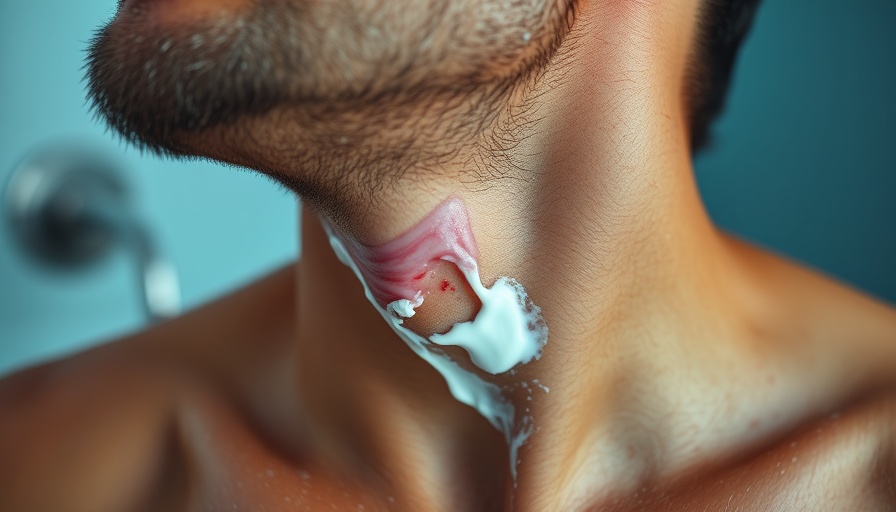
Understanding Razor Burn: A Common Skin Concern
Razor burn is an irritating and often painful skin reaction that many experience during their grooming routines. Whether you are a seasoned shaving veteran or new to the practice, razor burn can affect anyone, bringing along discomfort and unwanted redness. This article aims to unpack what razor burn is, how it occurs, and how to treat and prevent it.
What Causes Razor Burn?
Razor burn is fundamentally caused by the trauma that occurs as your razor blade glides over the skin’s surface. According to Dr. Joshua Zeichner, a leading dermatologist, this action can lead to microscopic cracks in the skin’s outer layer, resulting in inflammation, dryness, and irritation. Sensitive skin types are particularly vulnerable, making it crucial to recognize the signs early on.
Additionally, factors such as dry shaving—where no protective shaving cream or gel is applied—can significantly increase the risk of razor burn. Not using emollients while shaving deprives your skin of the moisture it desperately needs, leading to irritation and discomfort. Shaving too quickly or with a dull razor may exacerbate the problem, so it's essential to be mindful of your grooming technique.
Recognizing the Symptoms
The symptoms associated with razor burn can be uncomfortable and distressing. They typically manifest as:
- Itchiness
- Red patches or bumps
- Swelling
- A stinging or burning sensation
- Discomfort when touching the affected area
If the discomfort persists or worsens, it's essential to consult a dermatologist for an accurate diagnosis.
Diagnosis: When to Seek Help
Diagnosing razor burn is often straightforward. Dermatologists typically identify it based on your shaving history, symptom presentation, and the distinctive appearance of red, inflamed patches. If your symptoms don't resolve within a few days or if you notice skin changes, it's vital to seek professional advice to rule out other conditions that could mimic razor burn, such as folliculitis or contact dermatitis.
Practical Steps to Treat and Prevent Razor Burn
Understanding how to effectively manage and prevent razor burn can enhance your shaving experience. Here are several practical steps you can take:
- Moisturize: Always apply a quality shaving cream or gel to provide a protective barrier against your razor.
- Use the Right Tools: Regularly replace your razor blades to avoid dullness, which can lead to increased friction against the skin.
- Follow the Hair Growth: Shave in the direction of hair growth to minimize the chances of irritation.
- Shave After Showering: Shaving post-shower offers a significant advantage, as the warm water hydrates the hair and softens the skin.
- Aftercare Matters: Post-shave, applying an alcohol-free soothing lotion or aloe vera can help calm irritated skin.
Emotional and Human Perspectives: Managing Razor Burn
For many, dealing with razor burn can be more than a mere physical annoyance; it can affect self-esteem and confidence, particularly when the irritation is visible. The stigma surrounding skin issues can lead individuals to feel self-conscious, but it’s essential to remember that skin is inherently variable and requires care. Sharing personal experiences and solutions with others can foster community support and understanding.
Future Insights for Healthy Shaving
As you navigate your grooming habits, consider adopting a mindful approach to shaving. Keeping abreast of new shaving technologies and products that promote skin health can significantly improve your overall experience. Subscription services that curate quality shaving products tailored to individual skin needs are rising, making it easier than ever to find solutions that work for you.
Final Thoughts
Razor burn may be a common issue, but it's one that can be effectively managed with the right knowledge and techniques. The discomfort can be bothersome, but through understanding and proactive care, many can find relief. By incorporating these strategies into your shaving routine, you can minimize the risk of razor burn and maintain healthy skin.
Whether you're dealing with razor burn or looking to prevent it, don't hesitate to explore local resources, products, and experts to help you achieve smooth, healthy skin. Take the steps today for a more comfortable grooming experience tomorrow!
 Add Row
Add Row  Add
Add 




Write A Comment